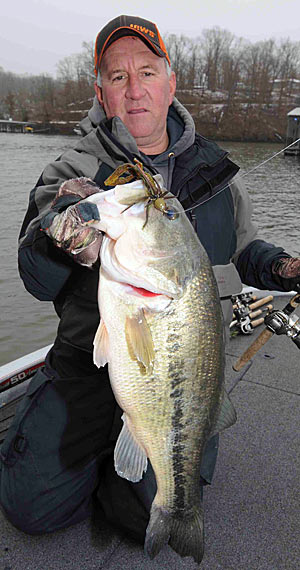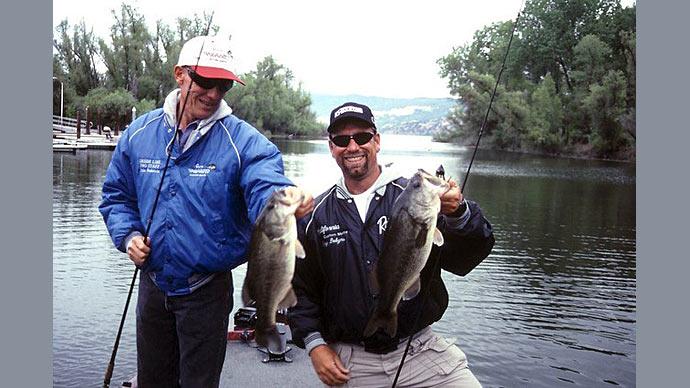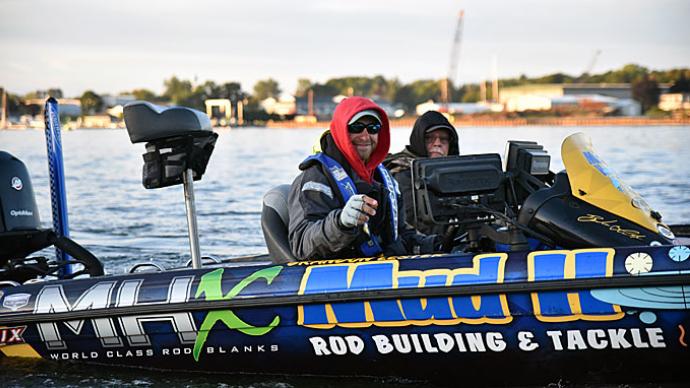
Wintertime bass fishing makes it hard to deal with the cold but easier to select lures for catching cold-water bass.
“That’s my favorite thing about wintertime is you can shrink down your arsenal, and once you get it tuned in and figured out, you can have one, two, or maybe three rods on the front deck,” says James Dill, a regional tournament angler and Lake of the Ozarks fishing guide.
The Missouri angler narrows his lure selection down to a handful of slow-moving lures to tempt wintertime bass. His top five winter lure picks are based on water clarity and temperature.
-
Creature Bait
When the water temperature drops below 44 degrees, Dill relies on a Crock-O-Gator Swamp Bug, a 3 1/4-inch creature bait with lively legs and a plastic grub-style tail. He rigs it on a 1/4-ounce Crock-O-Gator Shaker Football Head jig, allowing the Swamp Bug to sit upright to generate lots of tail action. His favorite colors for the Swamp Bug are moss candy for fishing in clear water and sunny days or green pumpkin for dirty water and cloudy weather.
Dill believes the lure’s tail and leg movement make the Swamp Bug an effective lure for sluggish bass. “You don’t have to retrieve it to have a lot of action,” Dill says. “Those little legs move even when the lure is sitting still.” He throws the Swamp Bug on 10- or 12-pound fluorocarbon and generates tail action to the lure by shaking his rod, so the bait hops 1 to 3 inches off the bottom without moving forward.
The Swamp Bug produces best for Dill at depths of 4 to 12 feet along transition banks such as spots where rocks change from shelf rock to boulders. The lure also works best for him on calm days, whether sunny or cloudy.
-
Jig and Craw
A 3/8-ounce Crock-O-Gator Zapper Jig in green, brown, or black hues tipped with Crock-O-Gator Ring Craw is Dill’s choice when the water temperature ranges from 44 to 50 degrees.
“It is a slow-moving bait and a crawfish imitator,” says Dill, who notices crawfish make a move when a lake goes through its winter drawdown. “The crawfish might be in 2 to 3 feet of water (before the drawdown), but when the lake draws down 5 or 6 feet, those crawfish--even though it is cold--will come out of their little haunts and have to get back in the water. The bass know that, and they get up there and root around for those crawfish.”
Rocks and brush piles are vital targets to throw a jig during the winter. “You want to throw it around larger rocks, ledges, and transition banks,” Dill says.
The fishing guide throws his jig to a steep bank and works it out to 15 feet deep. “I like to keep the jig bouncing, kind of hopping,” Dill says. “If you drag it, you will tend to miss bites because they are so subtle in the winter.” He notes that when dragging a jig, bass tend to pick up the bait and swim towards you, making it difficult to detect a strike.
- Suspending Stickbait
Image

A jig and craw is an ideal wintertime lure to throw when bass eat crawfish during a lake’s winter drawdown. When a cold snap hits or high pressure settles in, bass move off the bottom and suspend away from the bank. A suspending stickbait becomes the ideal lure for Dill in this situation. “You can let it sit suspended in front of the fish long enough that the fish will come up and investigate,” he says. Dill suggests the ideal time to throw the stickbait is during a shad die-off because the twitching of the lure mimics a dying shad.
Dill favors throwing the Megabass Vision 110 Jerkbait but suggests the Luck-E-Strike Rick Clunn Stx and Smithwick Rattlin’ Rogues are also suitable for suspending bass. He throws the stickbait on 6-, 8- or 10-pound fluorocarbon to the bank or over brush, and reels it down to its maximum depth. Varying his retrieve helps Dill determine how bass want the stickbait presented. “It’s all about figuring out what retrieve the fish want,” he says. “Do you want it to sit three or four seconds and then snap the line to make it move, or do you want to let it sit 25 seconds?”
The suspending stickbait is most productive for Dill when he works it over large rocks, bluff ends, 45-degree banks, or brush piles 6 to 18 feet deep. Dill considers sunny skies with a slight breeze ideal weather for throwing the stickbait.
-
Medium-Diving Crankbait
Early and late winter are prime times for Dill to throw medium-diving crankbaits such as the Storm Lures Wiggle Wart and Spro RkCrawler in crawfish colors.
Dill throws the crankbaits on rocky banks and points where he retrieves the lure steadily with 12-pound fluorocarbon line. “The key deal is allowing it to hit the rocks and stir up the bottom to entice the fish,” Dill says.
The Missouri angler likes to crank his crawfish imitators on sunny, breezy days.
-
Alabama Rig
Dill admits he is “not a big fan” of the Alabama rig. “But it is a very effective tool,” he says. “It imitates a small school of shad that has broken away from a large school of shad. Sometimes a large school of shad can be intimidating to bass, so if you have a bait like the Alabama rig with five swimbaits, it looks like an easy target for bass.”
Missouri state law allows only three hooks on an Alabama rig, so Dill puts three swimbaits with 1/8-ounce jigheads on the center and bottom wires of the rig and attaches two “dummy lures” without hooks on the top wires.
Dill sets up his rig with 3 1/2- to 4-inch swimbaits such as the Reaction Innovation Skinny Dipper or Zoom Swimmers in shad colors such as grayish blue with a dark back. He throws the rig on 50-pound braid line in stained water or 30-pound braid in clear water.
The rig can be retrieved down steep channel banks, over brush piles, or 18 to 30 feet deep pole timber. Dill lets the rig sink to the bottom before slowly retrieving it, or he will check his electronics to see how deep bass are and try to retrieve the rig slightly above the fish steadily.
The Alabama rig produces best for Dill on breezy, partly cloudy days when the water temperature ranges from 45 to 50 degrees.
BassResource may receive a portion of revenues if you make a purchase using a link above.




